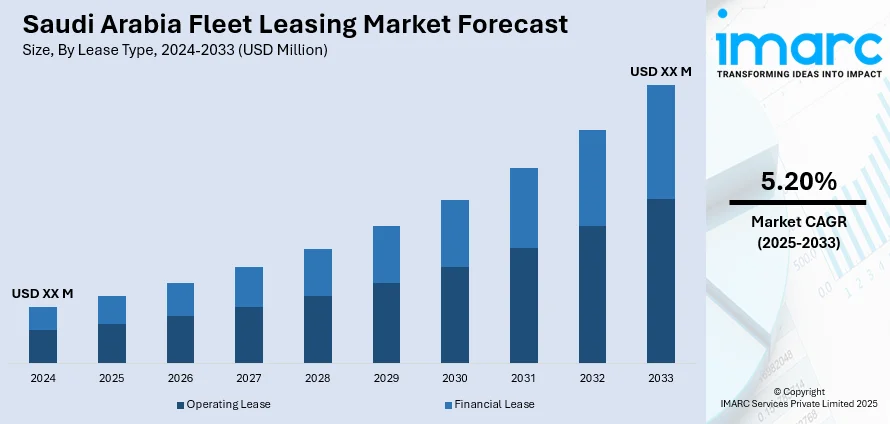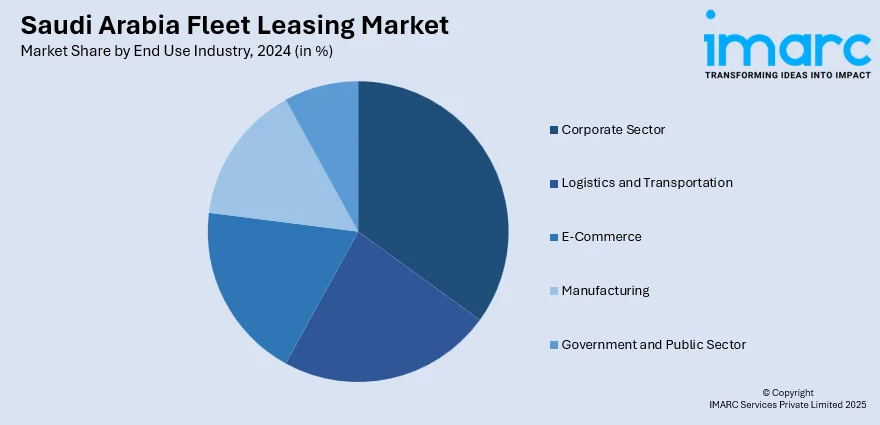
Saudi Arabia Fleet Leasing Market Size, Share, Trends and Forecast by Lease Type, Vehicle Type, Lease Duration, End Use Industry, and Region, 2025-2033
Saudi Arabia Fleet Leasing Market Overview:
The Saudi Arabia fleet leasing market size is projected to exhibit a growth rate (CAGR) of 5.20% during 2025-2033. The market is expanding due to rising demand for modern aircraft, growing participation of specialized operators, and strategic deals by national carriers. These factors are contributing to a steady increase in Saudi Arabia fleet leasing market share across both commercial and corporate aviation segments.
|
Report Attribute
|
Key Statistics
|
|---|---|
|
Base Year
|
2024
|
|
Forecast Years
|
2025-2033
|
|
Historical Years
|
2019-2024
|
| Market Growth Rate 2025-2033 | 5.20% |
Saudi Arabia Fleet Leasing Market Trends:
Fleet Expansion Aligned with National Strategy
Saudi Arabia’s fleet leasing market has gained significant momentum as airlines scale operations to meet national aviation goals under Vision 2030. Carriers are increasingly adopting leasing models to expand fleets without the financial burden of direct ownership, supporting flexibility and cost efficiency. A key development occurred in April 2025, when Saudia Group signed an agreement with Airbus to acquire up to 20 A 330neo wide-body aircraft, including 10 firm orders for its low-cost carrier, flyadeal. The transaction strengthened operational capacity, enhanced aircraft maintenance efficiency, and positioned the airline to accommodate projected growth in passenger traffic. The move directly supports Saudi Arabia’s objective to connect 250 destinations and serve over 330 Million travelers by 2030. As airline networks grow, leasing provides a strategic mechanism to manage capacity requirements and modernize fleets in line with evolving demand. These trends indicate that leasing is now a cornerstone of long-term fleet planning in the country. With continued investment in leased aircraft, Saudi Arabia is building a more agile and scalable aviation ecosystem. The steady adoption of advanced wide-body jets through leasing is enhancing connectivity, improving service quality, and driving sustained growth in the domestic fleet leasing market.

Rise of Specialized Aviation Leasing Entities
The emergence of specialized aviation operators is also reshaping Saudi Arabia fleet leasing market growth, focused on niche transport segments. These players are turning to leasing as a rapid and cost-effective way to meet operational demands without undergoing long acquisition processes. For instance, in December 2024, AerCap signed lease agreements with Aloula Aviation a wholly owned subsidiary of Aramco for two Boeing 737-800 aircraft. This marked Aloula’s first direct lease of passenger aircraft, expanding beyond its existing helicopter operations. The leased jets will be used for transporting Aramco personnel across regional airports, strengthening internal mobility and logistics. Aloula currently operates at 18 airports and manages more than 300 helipads, making its expansion into fixed-wing passenger service a strategic progression. This shift underscores the growing use of leasing to build capacity in support of corporate and industrial aviation needs. It also demonstrates how fleet leasing is no longer limited to commercial airlines but is being adopted by enterprise-led aviation operators. As more non-traditional entities enter the market, they are contributing to a more diverse leasing landscape, reinforcing the role of customized aircraft leasing solutions in Saudi Arabia’s broader transportation and logistics infrastructure.
Saudi Arabia Fleet Leasing Market Segmentation:
IMARC Group provides an analysis of the key trends in each segment of the market, along with forecasts at the country and regional level for 2025-2033. Our report has categorized the market based on lease type, vehicle type, lease duration and end use industry.
Lease Type Insights:
- Operating Lease
- Financial Lease
The report has provided a detailed breakup and analysis of the market based on the lease type. This includes operating lease and financial lease.
Vehicle Type Insights:
- Passenger Vehicles
- Light Commercial Vehicles (LCVs)
- Heavy Commercial Vehicles (HCVs)
A detailed breakup and analysis of the market based on the vehicle type have also been provided in the report. This includes passenger vehicles, light commercial vehicles (LCVS), and heavy commercial vehicles (HCVS).
Lease Duration Insights:
- Short-Term Leasing (Less than 12 months)
- Medium-Term Leasing (1-3 years)
- Long-Term Leasing (More than 3 years)
The report has provided a detailed breakup and analysis of the market based on the lease duration. This includes short-term leasing (less than 12 months), medium-term leasing (1-3 years), and long-term leasing (more than 3 years).
End Use Industry Insights:

- Corporate Sector
- Logistics and Transportation
- E-Commerce
- Manufacturing
- Government and Public Sector
A detailed breakup and analysis of the market based on the end use industry have also been provided in the report. This includes corporate sector, logistics and transportation, e-commerce, manufacturing, and government and public sector.
Regional Insights:
- Northern and Central Region
- Western Region
- Eastern Region
- Southern Region
The report has also provided a comprehensive analysis of all the major regional markets, which include Northern and Central region, Western region, Eastern region, and Southern region.
Competitive Landscape:
The market research report has also provided a comprehensive analysis of the competitive landscape. Competitive analysis such as market structure, key player positioning, top winning strategies, competitive dashboard, and company evaluation quadrant has been covered in the report. Also, detailed profiles of all major companies have been provided.
Saudi Arabia Fleet Leasing Market News:
- May 2025: AviLease, backed by Saudi Arabia’s Public Investment Fund, ordered up to 30 Boeing 737 MAX jets. The deal expanded its leasing portfolio to 200 aircraft, strengthening Saudi Arabia’s fleet leasing market and positioning AviLease as a growing player in global aviation leasing.
- January 2025: Almar Container Saudi Arabia signed a lease agreement with Folk Maritime to supply shipping containers, supporting fleet expansion and regional connectivity. This collaboration strengthened Saudi Arabia’s fleet leasing market by boosting container availability, enhancing operational flexibility, and aligning with the Vision 2030 logistics goals.
Saudi Arabia Fleet Leasing Market Report Coverage:
| Report Features | Details |
|---|---|
| Base Year of the Analysis | 2024 |
| Historical Period | 2019-2024 |
| Forecast Period | 2025-2033 |
| Units | Million USD |
| Scope of the Report |
Exploration of Historical Trends and Market Outlook, Industry Catalysts and Challenges, Segment-Wise Historical and Future Market Assessment:
|
| Lease Types Covered | Operating Lease, Financial Lease |
| Vehicle Types Covered | Passenger Vehicles, Light Commercial Vehicles (LCVs), Heavy Commercial Vehicles (HCVs) |
| Lease Durations Covered | Short-Term Leasing (Less than 12 months), Medium-Term Leasing (1-3 years), Long-Term Leasing (More than 3 years) |
| End Use Industries Covered | Corporate Sector, Logistics and Transportation, E-Commerce, Manufacturing, Government and Public Sector |
| Regions Covered | Northern and Central Region, Western Region, Eastern Region, Southern Region |
| Customization Scope | 10% Free Customization |
| Post-Sale Analyst Support | 10-12 Weeks |
| Delivery Format | PDF and Excel through Email (We can also provide the editable version of the report in PPT/Word format on special request) |
Key Questions Answered in This Report:
- How has the Saudi Arabia fleet leasing market performed so far and how will it perform in the coming years?
- What is the breakup of the Saudi Arabia fleet leasing market on the basis of lease type?
- What is the breakup of the Saudi Arabia fleet leasing market on the basis of vehicle type?
- What is the breakup of the Saudi Arabia fleet leasing market on the basis of lease duration?
- What is the breakup of the Saudi Arabia fleet leasing market on the basis of end use industry?
- What is the breakup of the Saudi Arabia fleet leasing market on the basis of region?
- What are the various stages in the value chain of the Saudi Arabia fleet leasing market?
- What are the key driving factors and challenges in the Saudi Arabia fleet leasing market?
- What is the structure of the Saudi Arabia fleet leasing market and who are the key players?
- What is the degree of competition in the Saudi Arabia fleet leasing market?
Key Benefits for Stakeholders:
- IMARC’s industry report offers a comprehensive quantitative analysis of various market segments, historical and current market trends, market forecasts, and dynamics of the Saudi Arabia fleet leasing market from 2019-2033.
- The research report provides the latest information on the market drivers, challenges, and opportunities in the Saudi Arabia fleet leasing market.
- Porter's five forces analysis assist stakeholders in assessing the impact of new entrants, competitive rivalry, supplier power, buyer power, and the threat of substitution. It helps stakeholders to analyze the level of competition within the Saudi Arabia fleet leasing industry and its attractiveness.
- Competitive landscape allows stakeholders to understand their competitive environment and provides an insight into the current positions of key players in the market.
Need more help?
- Speak to our experienced analysts for insights on the current market scenarios.
- Include additional segments and countries to customize the report as per your requirement.
- Gain an unparalleled competitive advantage in your domain by understanding how to utilize the report and positively impacting your operations and revenue.
- For further assistance, please connect with our analysts.
 Request Customization
Request Customization
 Speak to an Analyst
Speak to an Analyst
 Request Brochure
Request Brochure
 Inquire Before Buying
Inquire Before Buying




.webp)




.webp)












